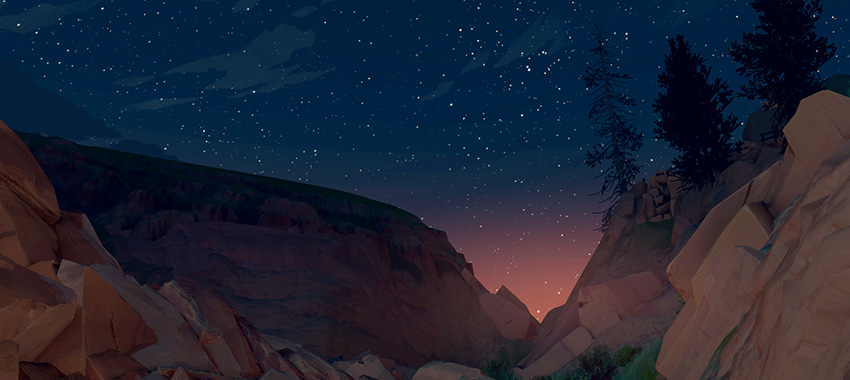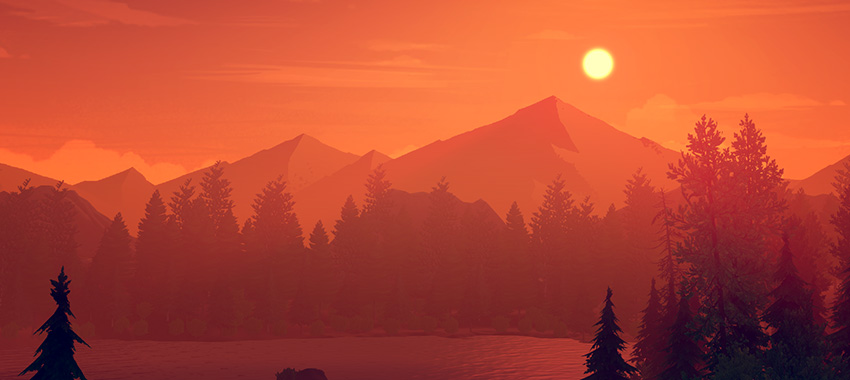By Nick Del Giudice, American Forests

Sunsets, gorgeous trees and solitude are all key elements to a good hike. In 2015, Campo Santo Studios, a young collective of seasoned video game developers, delivered a second-person experiential game. From the beginning, “Firewatch” was designed to immerse the player in both the wilderness of Wyoming’s Shoshone National Forest and the emotional struggles of our protagonist, Henry.

Henry is a wildland fire lookout. Fire lookouts have been a long romanticized and a rapidly disappearing breed of conservationist. The disappearance of the wilderness lookout is due to technological advances and a better understanding of the value of fire to the health of our forests. However, the romance is understandable — being paid to live up high among the trees and mountains, waking up with the sun and a perfect view. Although there are very few actual fire lookouts left, many of the old lookout towers can be rented as wilderness retreats. For the rest of us, there is “Firewatch” the game: a glimpse into the beautiful world of a wilderness lookout and the complex emotions of a person experiencing isolation in the wild.

It can be helpful to approach “Firewatch” not as a game, but as an experience. The actual game-play is easy to pick up and action isn’t the focus of the game. There are few props and no omniscience for the player — you only have the information Henry does; this lifelike minimalism completes the immersion. This is refreshing in the world of video games in which first-person action is usually accompanied by a heads-up display with all manner of information the character has no way of knowing in order to make the game easier. In “Firewatch,” there is no floating path in the air or magical GPS; you have a map. If you think you’re headed in the wrong direction, consult your compass. There is an authenticity to “Firewatch,” a step back from the modern world delivered via a high-tech video game.

Like many great real-life hikes, the appeal mostly comes from the visual experience. The visual style of “Firewatch” is both stunning, novel and somehow familiar. The game’s artistic director, Olly Moss is a graphic designer from the U.K. specializing in recreating movie posters. The inspiration for the game design is none other than the early-20th-century promotional posters issued by the National Park Service (NPS) and the U.S. Forest Service. While the posters may have informed the style of the game, the substance is purely the American West. Writer Sean Vanaman told us about his childhood, enjoying the great outdoors in Wyoming’s Absaroka Wilderness, and developing the game.
“We needed the rest of the team to have experiences in the mountains of the American West,” Vanaman said. “Multiple team members are from England, so we took everyone to Yosemite and pulled as much reference of scale and expanse as possible.”
Video game environments are often just a setting, but in “Firewatch” the environment is the key to the story. With “Firewatch,” outdoors enthusiasts can find another outlet to express their passion and perhaps someone who would otherwise not interact with wilderness to get outside.
” felt like if we could make a game that was beautiful enough and celebrated the wilderness as much as possible, it would, in turn, make customers care the way we did and create interest in getting out there themselves,” said Vanaman. “We’ve had countless fans email us that this worked for them. Some now volunteer for the NPS, others have become avid campers and outdoorsmen after spending years and years inside. It’s pretty amazing.”
The experience of exploring public lands is an inspiration to many at Campo Santo Studios, including Vanaman.
“These spaces are one of the things that make this country incredible,” he said. “So many countries don’t have what we have — land you can go do what you want on that hasn’t been taken over by someone else with a pocketbook.”
By showcasing the wonder of public lands in a multimedia format, perhaps some people without the ability to visit our wild spaces will be inspired. Vanaman, who was born in Ireland, remarked on the loss of forests across Western Europe and why conservation is so important.
“Becoming a steward of these places was essential to the way I grew up thinking about America,” he said. “I’m quite proud we were able to celebrate them in a small way inside of ‘Firewatch.’”
